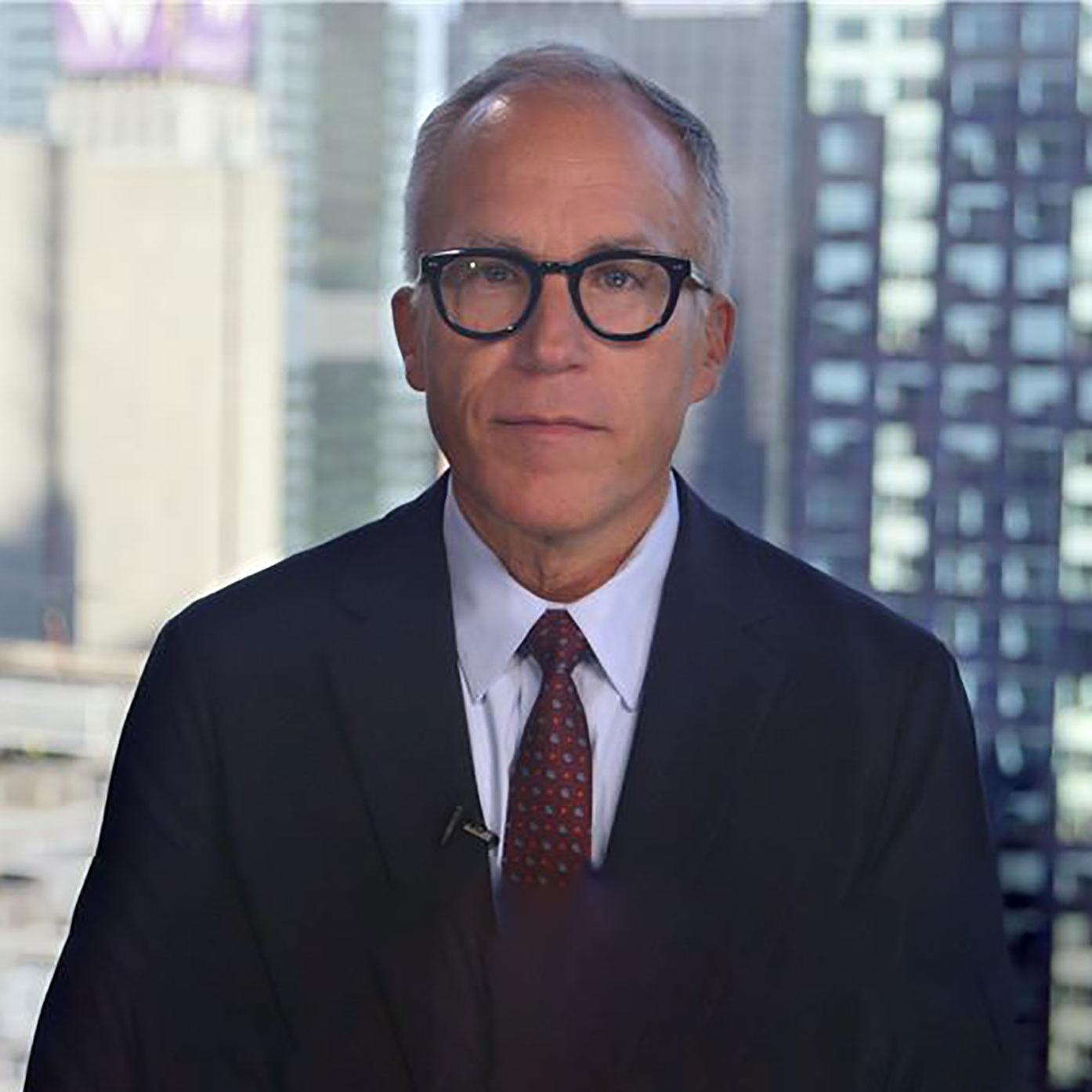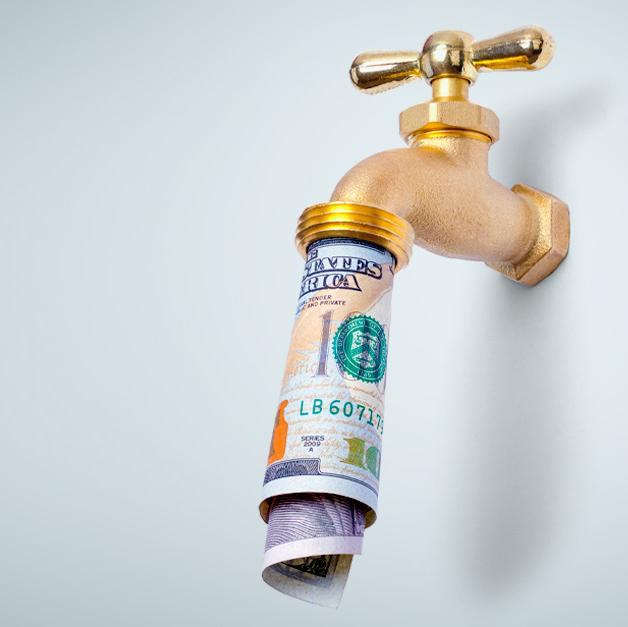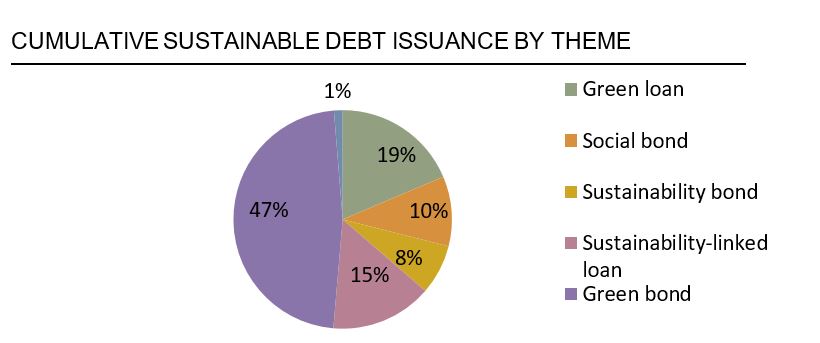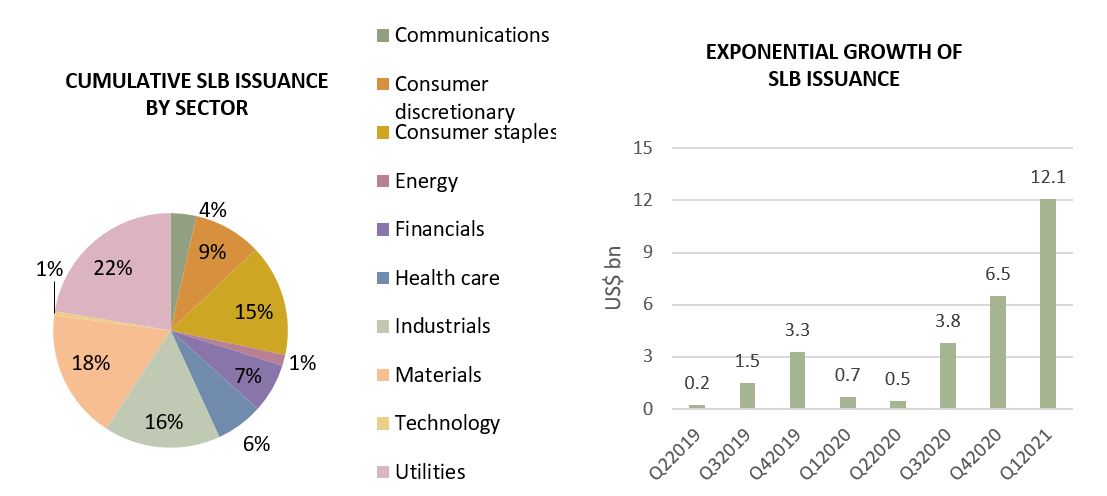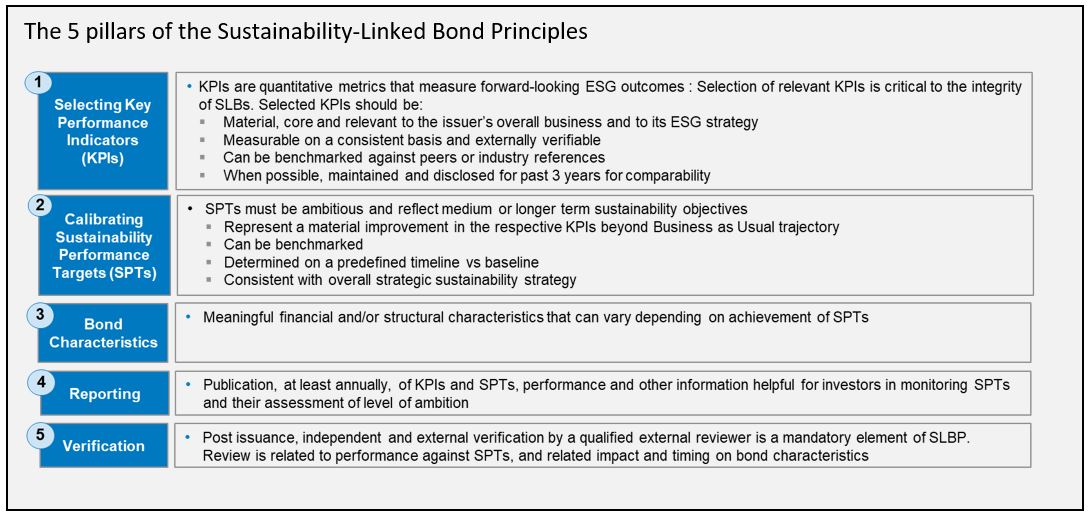
Innovation in Sustainability-Linked Model Fuels Booming Demand
- Courriel
-
Signet
-
Imprimer
Disponible en anglais seulement
Unstoppable. That’s one word that might describe the recent growth in the sustainable debt market. Driven by its most recent innovation - the so-called sustainability-linked model - the sustainable debt market now exceeds US$2.8tn of issuance across various instruments, eclipsing the US$1tn of issuance that was so trumpeted in the green bond market last year.
Addressing a Market Gap
Shortly after the publication of the Sustainability-Linked Bond (“SLB”) Principles in June 2020 (see below) by the International Capital Market Association (“ICMA”), the sustainable debt market witnessed a rocketing number of issuances of those new instruments, reaching US$35.5bn1 as of April 30, 2021 across a wide range of issuers and industries - 65 issuers over 10 industries - evidencing both strong market appetite and acceptance for this new innovative asset class2. The EMEA region has been leading the charge (as it is with sustainable debt in general), with US$24.8bn of issuances, however AMER and APAC regions are following with US$7.33bn and US$3.38bn of issuances, respectively.
The reason for innovation to turn its focus on the development of the sustainability-linked bond asset class is rooted in the need to address a market gap and potential limitations of the Green/Social and Sustainability bonds model. This incredible growth is bolstered by the desire of a broader base of issuers to signal their sustainability strategies and level of commitment to the investment community in an environment where transition taxonomies around the globe are stalling and markets have yet to arrive at a unanimously agreed upon definition of transition. As a result, the sustainability-linked bond market has mirrored the adoption success of the sustainability-linked loan, its cousin in the bank market that has itself roared from 45 issuers in 2018 to 350+ global issuers these days, with a market size of US$422.6bn1 as of April 2021.
The flexibility offered by the bond format, which does not require a dedicated ‘green’ or ‘social’ use of proceeds in the way that traditional Green, Social or Sustainability bonds do, has proven appealing to corporate bond issuers. Indeed, the SLB can be used for general corporate purposes and is meant to motivate the issuer to greater sustainability as a forward-looking instrument. As a result, while the traditional use of proceeds bonds (green/social/sustainability) were pioneered by SSAs, they are so far absent in an SLB market that is dominated by Corporates.
Built-in Incentives Demonstrate Corporate Sustainability Strategy
As an increasing number of corporates establish sustainability commitments and targets that encompass a broad range of issues (with the most popular being decarbonization at large), some have doubled down by tying those to financial outcomes built into sustainability-linked bonds.
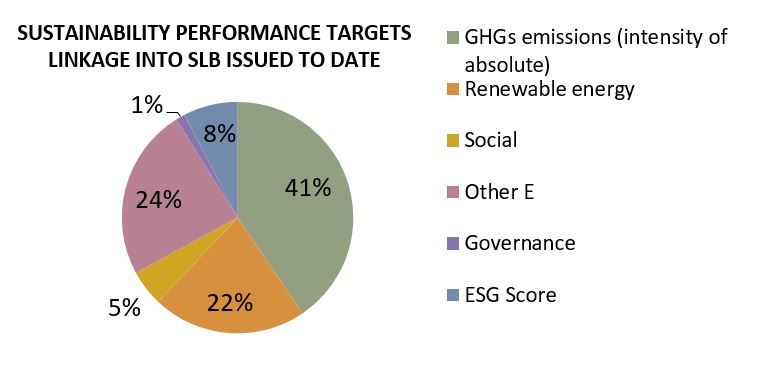
A sustainability-linked labelled bond implies that either a financial or structural characteristic of the bond will vary depending on achieving pre-agreed Sustainability Performance Targets by a certain date within the life of the bond.
Effectively, in cases where the issuer does not achieve the set targets, most of the US$35.5bn SLBs issued in the market have an interim coupon, step-up feature built into the bond, ranging from 25 to 75bps, possibly spread across several Sustainability Performance Targets. For example, Constellium SE’s US$500mm SLB executed in February of this year will experience a 12.5 basis points coupon step-up in the event that the first sustainability performance target of 25% reduction in GHG emission intensity is not achieved by December 31, 2025, and another 12.5 basis points coupon step-up in 2026 in case of failure to achieve the second 10% increase in recycled aluminum input target. Where the company is successful achieving its targets, the bond characteristics won’t change.
Innovative alternative penalties approaches have also emerged, ultimately supporting achievement of the issuer’s sustainability strategy. In LafargeHolcim’s EUR 850mm SLB transaction executed in November 2020, for example, the 75bps potential coupon step-up could be donated to a research institute active in the fields of climate research or climate change mitigation, or reallocated internally to an R&D budget dedicated to cement decarbonization. In Etihad’s US$600mm SLB deal in October 2020, failure to achieve its decarbonization target at the target observation date would not trigger a coupon step-up but instead an obligation to buy carbon offsets.
While we expect further innovation in the bond incentive structure and alternate pay-off mechanisms, we foresee limited investors’ appetite to accept coupon step-down in the case of successful achievement of the sustainability performance target – whereas this has been market practice in the bank market for sustainability-linked loan instruments.
Materiality, Ambition and Transparency
For investors, SLBs also provide greater visibility into the overall sustainability strategy of the issuer, and help drive diversification in labelled bonds portfolios with a broadening of the range of issuers, geographies and industries beyond the traditional, often low-yield green bond market, including sustainability-linked bond issuances from high yield issuers (e.g. EUR 500mm Public Power Corp.’s SLB, carrying a higher coupon of 50 bps if it fails to reduce its CO2 emissions by 40% by December 2022 from 2019 levels). That said, some investors have yet to participate in the SLB market, citing difficulty assessing the calibration of sustainability targets, reconciling bond impacts or other practical challenges into portfolio inclusion.
A core element of the SLB is whether the Key Performance Indicators (“KPI”) are material for the business and whether the targets are set at a level that is ambitious enough and beyond business-as-usual. To opine on such, the market relies again on a critical part of the integrity of sustainable finance: TRANSPARENCY. For the market to thrive, transparency is critical to explaining the materiality of the KPI, the targets comparability and ambition as well as context within the issuer’s strategy and broader industry.
Beyond ICMA’s guidelines on KPI materiality, there is also a lot of discussion in the market on the concept of proportionality regarding the amount raised in consideration to potential investments needed to achieve the sustainability targets as well as calibration of the potential coupon step-up in connection with the ambition level or bond pricing. Considering the still nascent state of the SLB market, those discussions are meant to and will evolve overtime as more issuances come to market and a “critical mass” is reached.
As with the “use of proceeds” bond market, the new kid on the block will gain further acceptance and earn increased credibility as a function of issuer transparency and integrity around their sustainability ambitions and progress trajectory. Despite potential challenges, the SLB can be regarded as an important signalling and financing tool in the sustainable finance toolbox, and help issuers telegraph their sustainability strategy and demonstrate related goals.
Evolving Menu of Sustainability Options
Overall, evolving investors’ expectations have contributed to product innovation and deployment of a “menu” of sustainable debt options to finance their sustainability objectives or demonstrate various ESG commitments. The acceleration in standardization in 2020 with the publications of new standards along with enforcement of regulations have enhanced the market and the volume of new issuances of sustainability-linked products is expected to continue its ascension over the coming quarters – including potentially for some sectors adopting a combined format with the traditional use of proceeds model as we’ve seen with two sustainability-linked green bonds issued in March.
- Selectin Key Performance Indicators(KPIs)
- Calibrating Sustainability Performance Targets (SPTs)
- Bond Characteristics
- Reporting
- Verification
1 As per BNEF
2 Including European Central Bank accepting SLBs as central bank collaterals since January 2021

Innovation in Sustainability-Linked Model Fuels Booming Demand
Directrice, Finance durable
Magali Gable a rejoint l’équipe de Finance durable de BMO au début de 2020. Elle dessert les clients de BMO dans les secteurs de l’&e…
Magali Gable a rejoint l’équipe de Finance durable de BMO au début de 2020. Elle dessert les clients de BMO dans les secteurs de l’&e…
VOIR LE PROFIL COMPLET-
Temps de lecture
-
Écouter
Arrêter
-
Agrandir | Réduire le texte
Disponible en anglais seulement
Unstoppable. That’s one word that might describe the recent growth in the sustainable debt market. Driven by its most recent innovation - the so-called sustainability-linked model - the sustainable debt market now exceeds US$2.8tn of issuance across various instruments, eclipsing the US$1tn of issuance that was so trumpeted in the green bond market last year.
Addressing a Market Gap
Shortly after the publication of the Sustainability-Linked Bond (“SLB”) Principles in June 2020 (see below) by the International Capital Market Association (“ICMA”), the sustainable debt market witnessed a rocketing number of issuances of those new instruments, reaching US$35.5bn1 as of April 30, 2021 across a wide range of issuers and industries - 65 issuers over 10 industries - evidencing both strong market appetite and acceptance for this new innovative asset class2. The EMEA region has been leading the charge (as it is with sustainable debt in general), with US$24.8bn of issuances, however AMER and APAC regions are following with US$7.33bn and US$3.38bn of issuances, respectively.
The reason for innovation to turn its focus on the development of the sustainability-linked bond asset class is rooted in the need to address a market gap and potential limitations of the Green/Social and Sustainability bonds model. This incredible growth is bolstered by the desire of a broader base of issuers to signal their sustainability strategies and level of commitment to the investment community in an environment where transition taxonomies around the globe are stalling and markets have yet to arrive at a unanimously agreed upon definition of transition. As a result, the sustainability-linked bond market has mirrored the adoption success of the sustainability-linked loan, its cousin in the bank market that has itself roared from 45 issuers in 2018 to 350+ global issuers these days, with a market size of US$422.6bn1 as of April 2021.
The flexibility offered by the bond format, which does not require a dedicated ‘green’ or ‘social’ use of proceeds in the way that traditional Green, Social or Sustainability bonds do, has proven appealing to corporate bond issuers. Indeed, the SLB can be used for general corporate purposes and is meant to motivate the issuer to greater sustainability as a forward-looking instrument. As a result, while the traditional use of proceeds bonds (green/social/sustainability) were pioneered by SSAs, they are so far absent in an SLB market that is dominated by Corporates.
Built-in Incentives Demonstrate Corporate Sustainability Strategy
As an increasing number of corporates establish sustainability commitments and targets that encompass a broad range of issues (with the most popular being decarbonization at large), some have doubled down by tying those to financial outcomes built into sustainability-linked bonds.

A sustainability-linked labelled bond implies that either a financial or structural characteristic of the bond will vary depending on achieving pre-agreed Sustainability Performance Targets by a certain date within the life of the bond.
Effectively, in cases where the issuer does not achieve the set targets, most of the US$35.5bn SLBs issued in the market have an interim coupon, step-up feature built into the bond, ranging from 25 to 75bps, possibly spread across several Sustainability Performance Targets. For example, Constellium SE’s US$500mm SLB executed in February of this year will experience a 12.5 basis points coupon step-up in the event that the first sustainability performance target of 25% reduction in GHG emission intensity is not achieved by December 31, 2025, and another 12.5 basis points coupon step-up in 2026 in case of failure to achieve the second 10% increase in recycled aluminum input target. Where the company is successful achieving its targets, the bond characteristics won’t change.
Innovative alternative penalties approaches have also emerged, ultimately supporting achievement of the issuer’s sustainability strategy. In LafargeHolcim’s EUR 850mm SLB transaction executed in November 2020, for example, the 75bps potential coupon step-up could be donated to a research institute active in the fields of climate research or climate change mitigation, or reallocated internally to an R&D budget dedicated to cement decarbonization. In Etihad’s US$600mm SLB deal in October 2020, failure to achieve its decarbonization target at the target observation date would not trigger a coupon step-up but instead an obligation to buy carbon offsets.
While we expect further innovation in the bond incentive structure and alternate pay-off mechanisms, we foresee limited investors’ appetite to accept coupon step-down in the case of successful achievement of the sustainability performance target – whereas this has been market practice in the bank market for sustainability-linked loan instruments.
Materiality, Ambition and Transparency
For investors, SLBs also provide greater visibility into the overall sustainability strategy of the issuer, and help drive diversification in labelled bonds portfolios with a broadening of the range of issuers, geographies and industries beyond the traditional, often low-yield green bond market, including sustainability-linked bond issuances from high yield issuers (e.g. EUR 500mm Public Power Corp.’s SLB, carrying a higher coupon of 50 bps if it fails to reduce its CO2 emissions by 40% by December 2022 from 2019 levels). That said, some investors have yet to participate in the SLB market, citing difficulty assessing the calibration of sustainability targets, reconciling bond impacts or other practical challenges into portfolio inclusion.
A core element of the SLB is whether the Key Performance Indicators (“KPI”) are material for the business and whether the targets are set at a level that is ambitious enough and beyond business-as-usual. To opine on such, the market relies again on a critical part of the integrity of sustainable finance: TRANSPARENCY. For the market to thrive, transparency is critical to explaining the materiality of the KPI, the targets comparability and ambition as well as context within the issuer’s strategy and broader industry.
Beyond ICMA’s guidelines on KPI materiality, there is also a lot of discussion in the market on the concept of proportionality regarding the amount raised in consideration to potential investments needed to achieve the sustainability targets as well as calibration of the potential coupon step-up in connection with the ambition level or bond pricing. Considering the still nascent state of the SLB market, those discussions are meant to and will evolve overtime as more issuances come to market and a “critical mass” is reached.
As with the “use of proceeds” bond market, the new kid on the block will gain further acceptance and earn increased credibility as a function of issuer transparency and integrity around their sustainability ambitions and progress trajectory. Despite potential challenges, the SLB can be regarded as an important signalling and financing tool in the sustainable finance toolbox, and help issuers telegraph their sustainability strategy and demonstrate related goals.
Evolving Menu of Sustainability Options
Overall, evolving investors’ expectations have contributed to product innovation and deployment of a “menu” of sustainable debt options to finance their sustainability objectives or demonstrate various ESG commitments. The acceleration in standardization in 2020 with the publications of new standards along with enforcement of regulations have enhanced the market and the volume of new issuances of sustainability-linked products is expected to continue its ascension over the coming quarters – including potentially for some sectors adopting a combined format with the traditional use of proceeds model as we’ve seen with two sustainability-linked green bonds issued in March.
- Selectin Key Performance Indicators(KPIs)
- Calibrating Sustainability Performance Targets (SPTs)
- Bond Characteristics
- Reporting
- Verification
1 As per BNEF
2 Including European Central Bank accepting SLBs as central bank collaterals since January 2021
Autre contenu intéressant
A Buyer’s Guide to Corporate Offsetting and Navigating the Voluntary Carbon Market
Pourquoi la durabilité est une source de bonnes affaires : Principaux points retenus du Forum économique international des Amériques (FEIA) de 2024, à Toronto

Building for Tomorrow: Real Estate, Construction, and Sustainability
Comment les entreprises peuvent s’y retrouver dans le cadre de la politique climatique du Canada
Une première dans l'Ouest canadien : Avenue Living tire parti du programme d'amélioration écoénergétique de BMO pour ajouter 179 nouveaux logements locatifs dans le centre-ville d'Edmonton
Le coût des plans d’action des entreprises en matière de climat
Risque climatique : changements réglementaires à surveiller en 2024

Comment la NASA et IBM utilisent les données géospatiales et l’intelligence artificielle pour analyser les risques climatiques
L’obligation de publier de l’information sur les facteurs ESG est le signe d’un marché arrivé à maturité
BMO organise un financement vert pour financer le nouveau Lawson Centre for Sustainability, la construction la plus importante de Trinity College depuis un siècle
BMO se classe parmi les sociétés les plus durables d'Amérique du Nord selon les indices de durabilité Dow Jones
Le Canada a l’occasion de devenir un chef de file mondial de l’élimination du dioxyde de carbone
Selon un sondage réalisé par l'Institut pour le climat de BMO auprès des chefs d'entreprise, près de la moitié des chefs d'entreprise des États-Unis et du Canada croient que les changements climatique
Un plus grand nombre d’entreprises ont des plans pour lutter contre les changements climatiques en raison de l’importance croissante qu’ils revêtent sur leurs activités : Résultats du sondage
L’électrification constitue une occasion unique dans le cadre de la transition énergétique
Le soutien du secteur de l’énergie dans l’atteinte des objectifs de décarbonisation du Canada
Questions et réponses : comment transformer les défis économiques en possibilités
Trois idées inspirées de la Semaine du climat pour passer à l’action à la COP28
Du caractère essentiel du financement pour doper les technologies d’élimination du carbone
Pourquoi les entreprises doivent accélérer leurs efforts pour lutter contre les changements climatiques
Transformer le système alimentaire mondial au bénéfice des investisseurs et de la planète
Banco do Brasil and BMO Financial Group to Introduce First-of-its-Kind Program to Provide Sustainability-Linked Trade Loans Supporting Brazilian Exporters
BMO Donates $3 Million to GRID Alternatives to Provide Solar Energy Solutions for Low-Income Families

Comment les investissements dans le captage du carbone peuvent générer des crédits carbone
BMO fournit un nouveau produit innovant, le dépôt lié à la durabilité, à Zurn Elkay Water Solutions

Quick Listen: Michael Torrance on Empowering Your Organization to Operationalize Sustainability
BMO seule grande banque nommée au palmarès des 50 meilleures entreprises citoyennes au Canada
Un investissement rentable : la rénovation comme moyen d’atteindre la carboneutralité
Évolution du marché du carbone : ce qu’en pensent les principaux acteurs
BMO et Bell Canada mettent en œuvre un produit dérivé innovant lié à la durabilité et à des objectifs ambitieux de réduction des émissions de gaz à effet de serre
BMO fait partie d'un groupe convoqué par l'ONU qui conseille les banques mondiales sur l'établissement d'objectifs liés à la nature
Les chefs de file de l’investissement intensifient leurs efforts en vue d’atteindre l’objectif net zéro
Favoriser les innovations technologiques pour renforcer la résilience face aux changements climatiques
BMO célèbre le Jour de la Terre avec la 3e édition annuelle du programme Des transactions qui font pousser des arbres dans ses salles des marchés mondiaux
BMO Donates $2 Million to the University of Saskatchewan to Accelerate Research Critical to the Future of Food
Le temps presse pour les solutions au changement climatique - Sommet Canada-États-Unis

North America’s Critical Minerals Advantage: Deep Dive on Community Engagement
Réchauffement climatique : le GIEC lance son dernier avertissement de la décennie
Explorer les risques et les possibilités associés aux notations ESG dans le secteur minier
La confiance est la denrée la plus précieuse : Message de l’ICMM à la Conférence mondiale sur les mines, métaux et minéraux critiques de BMO
Exploration des avantages de l’extraction de minéraux critiques en Amérique du Nord dans le cadre de la Conférence mondiale sur les mines, métaux et minéraux critiques
Les légendes du roc réfléchissent aux réussites et aux échecs de l’industrie minière lors de la Conférence mondiale sur les mines, métaux et minéraux critiques
BMO Experts at our 32nd Global Metals, Mining & Critical Minerals Conference

Evolving Mining for a Sustainable Energy Transition: ICMM CEO Rohitesh Dhawan in Conversation

BMO Equity Research on BMO Radicle and the World of Carbon Credits

Public Policy and the Energy Transition: Howard Learner in Conversation

Taskforce on Nature-Related Financial Disclosure (TNFD) – A Plan for Integrating Nature into Business
Points à retenir du sondage sur le climat des petites et moyennes entreprises réalisé par l’Institut pour le climat de BMO
BMO nommée banque la plus durable d'Amérique du Nord par Corporate Knights pour la quatrième année d'affilée
Le financement vert du nucléaire : nouvelle frontière de la transition énergétique?
Assurer l’avenir des approvisionnements alimentaires : le rôle de l’Amérique du Nord
BMO s'est classé parmi les entreprises les plus durables en Amérique du Nord selon les indices de durabilité Dow Jones
Un sondage de l'Institut pour le climat de BMO révèle que les coûts et les priorités concurrentes ralentissent l'action climatique des petites et moyennes entreprises
Gérer et monétiser votre transition vers un monde carboneutre avec BMO et Radicle
BMO est l'institution financière la mieux classée selon le Global Sustainability Benchmark, le nouvel indice de référence mondial du développement durable annoncé lors de la COP 27

COP27 : Les problèmes de sécurité énergétique et l’incertitude économique ralentiront-t-ils la transition climatique?
BMO investira dans les crédits compensatoires de carbone novateurs de CarbonCure pour stocker du CO₂ de façon permanente
Financement commercial : vers le développement durable, une entreprise à la fois

RoadMap Project: An Indigenous-led Paradigm Shift for Economic Reconciliation
Une première canadienne : BMO et l'Université Concordia s'unissent pour un avenir durable grâce à un prêt innovant lié à la durabilité

Intégration des facteurs ESG dans les petites et moyennes entreprises : Conférence de Montréal
BMO entend racheter Radicle Group Inc., un chef de file des services environnementaux situé à Calgary

Investment Opportunities for a Net-Zero Economy: A Conversation at the Milken Institute Global Conference
S’ajuster face aux changements climatiques : l’Institut pour le climat de BMO

How Hope, Grit, and a Hospital Network Saved Maverix Private Capital Founder John Ruffolo

Hydrogen’s Role in the Energy Transition: Matt Fairley in Conversation

Key Takeaways on Ag, Food, Fertilizer & ESG from BMO’s Farm to Market Conference
Les risques physiques et liés à la transition auxquels font face l’alimentation et l’agriculture

Building an ESG Business Case in the Food Sector: The Food Institute
BMO et EDC annoncent une collaboration pour présenter des solutions de financement durable aux entreprises canadiennes

Refonte au Canada pour un monde carboneutre : Conversation avec Corey Diamond d’Efficacité énergétique Canada

The Role of Hydrogen in the Energy Transition: FuelCell Energy CEO Jason Few in Conversation
BMO est fier de soutenir la première transaction d'obligations vertes du gouvernement du Canada en tant que cochef de file
Article d’opinion: Le Canada peut être un leader en matière de sécurité énergétique
Les mesures prises par le gouvernement peuvent contribuer à stimuler la construction domiciliaire afin de remédier à la pénurie de logements au Canada

Tackling Climate Change in Metals and Mining: ICMM CEO Rohitesh Dhawan in Conversation
La circulaire de sollicitation de procurations et les rapports sur la durabilité 2021 de BMO sont maintenant disponibles

Why Changing Behaviour is Key to a Low Carbon Future – Dan Barclay
BMO lance le programme Services aux entreprises à portée de main - BMO pour les entrepreneurs noirs et annonce un engagement de 100 millions de dollars en prêts pour aider les entrepreneurs noirs à dé

The Post 2020 Biodiversity Framework – A Discussion with Basile Van Havre
BMO annonce son intention de se joindre au programme Catalyst de Breakthrough Energy pour accélérer l'innovation climatique
BMO Groupe financier nommé banque la plus durable en Amérique du Nord pour la troisième année d'affilée

Using Geospatial Big Data for Climate, Finance and Sustainability
Atténuer les répercussions des changements climatiques sur les actifs physiques par la finance spatiale
BMO aide Boralex à aller Au-delà des énergies renouvelables en transformant sa facilité de crédit en un prêt lié au développement durable
Première mondiale : BMO soutient Bruce Power avec le premier cadre de financement vert du secteur nucléaire au monde
BMO se classe parmi les entreprises les plus durables au monde, selon les indices de durabilité Dow Jones
COP26 : Pourquoi les entreprises doivent assumer leur responsabilité sociale
The Future of Remote Work and Diversity in the Asset Management Industry
Changer les comportements est essentiel pour assurer un avenir à faible émission de carbone – Table ronde Milken
BMO aide Teck Resources à progresser vers ses objectifs ESG avec un prêt lié à la durabilité
Première dans le secteur des métaux et des mines en Amérique du Nord : BMO aide Sandstorm Gold Royalties à atteindre ses objectifs ESG grâce à un prêt lié à la durabilité
Éducation, emploi et autonomie économique : BMO publie Wîcihitowin ᐑᒋᐦᐃᑐᐏᐣ, son premier Rapport sur les partenariats et les progrès en matière autochtone annuel
BMO annonce un engagement de financement de 12 milliards de dollars pour le logement abordable au Canada
BMO appuie la candidature du Canada pour accueillir le siège du Conseil des normes internationales d'information sur la durabilité
In support of Canada’s bid to host the headquarters of the International Sustainability Standards Board
Investing in Real Estate Sustainability with Bright Power Inc.
BMO nommé au classement des 50 meilleures entreprises citoyennes au Canada de Corporate Knights
ESG From Farm to Fork: Doing Well by Doing Good
L’appétit croissant pour l’investissement dans un but précis dans les valeurs à revenu fixe par Magali Gable
Banques centrales, changements climatiques et leadership : Forum annuel destiné aux femmes œuvrant dans le secteur des titres à revenu fixe, devises et produits de base
BMO met sur pied une nouvelle équipe innovatrice pour la transition énergétique
Première nord-américaine : BMO aide Gibson Energy à transformer entièrement une facilité de crédit en un prêt lié à la durabilité
Le programme Des transactions qui font pousser des arbres permettra d’en planter 100 000

Understanding Biodiversity Management: Best Practices and Innovation
Les arbres issus des métiers bénéficient d'un marché obligataire ESG solide

The Changing Face of Sustainability: tentree for a Greener Planet
Favoriser des résultats durables : le premier prêt vert offert au Canada

Episode 29: What 20 Years of ESG Engagement Can Teach Us About the Future
Rapport sur les perspectives de 2021 de BMO Gestion mondiale d'actifs : des jours meilleurs à venir

Episode 28: Bloomberg: Enhancing ESG Disclosure through Data-Driven Solutions
Comment Repérer L’écoblanchiment Et Trouver Un Partenaire Qui Vous Convient
BMO se classe parmi les entreprises les plus durables selon l'indice de durabilité Dow Jones - Amérique du Nord

Episode 27: Preventing The Antimicrobial Resistance Health Crisis
BMO investit dans un avenir durable grâce à un don d’un million de dollars à l’Institute for Sustainable Finance
BMO Groupe financier franchit une étape clé en faisant correspondre 100 pour cent de sa consommation d'électricité avec des énergies renouvelables
BMO Groupe financier reconnu comme l'une des sociétés les mieux gérées de manière durable au monde dans le nouveau classement du Wall Street Journal

Episode 23: TC Transcontinental – A Market Leader in Sustainable Packaging
Les possibilités de placement durables dans le monde d’après la pandémie
Les sociétés axées sur l’efficacité énergétique peuvent maintenant réduire leurs coûts d’emprunt
BMO Groupe financier s'approvisionnera à 100 pour cent en électricité à partir d'énergies renouvelables

Episode 13: Faire face à la COVID-19 en optant pour des solutions financières durables

Épisode 09 : Le pouvoir de la collaboration en matière d'investissement ESG

Épisode 08 : La tarification des risques climatiques, avec Bob Litterman

Épisode 07 : Mobiliser les marchés des capitaux en faveur d’une finance durable

Épisode 06 : L’investissement responsable – Tendances et pratiques exemplaires canadiennes

Épisode 04 : Divulgation de renseignements relatifs à la durabilité : Utiliser le modèle de SASB

Épisode 03 : Taxonomie verte: le plan d'action pour un financement durable de l'UE

Épisode 02 : Analyser les risques climatiques pour les marchés financiers




